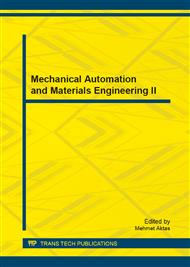p.539
p.544
p.549
p.554
p.559
p.564
p.569
p.574
p.580
Signal Analysis of Magnetic Control Seam Tracking Based on the Hilbert-Huang Transform
Abstract:
According to the fact that the nonlinear magnetic control welding signal is not smooth, this paper proposes a signal extraction and an analytical method of the system based on Hilbert-Huang transform magnetic control arc seam tracking sensor. First, the magnetic control to track the signal motivated by cycle is decomposed into several intrinsic mode functions from high frequency to low frequency component by using the empirical mode decomposition. On the basis of the Hilbert marginal spectrum of each component, distribution of time-frequency transform to each component can effectively restrain cross terms and extract the real-time signal dynamic law reflecting magnetic control seam tracking. This method used in a certain experimental platform for magnetic control arc welding seam tracking sensor platform signal analysis, has produced a good effect and extracted the seam tracking signal, which can offer more valuable information and help to further reveal the frequency and spectrum characteristics of various interference sources in the weld automatic tracking system. Furthermore, It also provides a theoretical basis for establishing the welding signals with excitation source as well as a new nonlinear model.
Info:
Periodical:
Pages:
559-563
Citation:
Online since:
June 2014
Authors:
Price:
Сopyright:
© 2014 Trans Tech Publications Ltd. All Rights Reserved
Share:
Citation:


